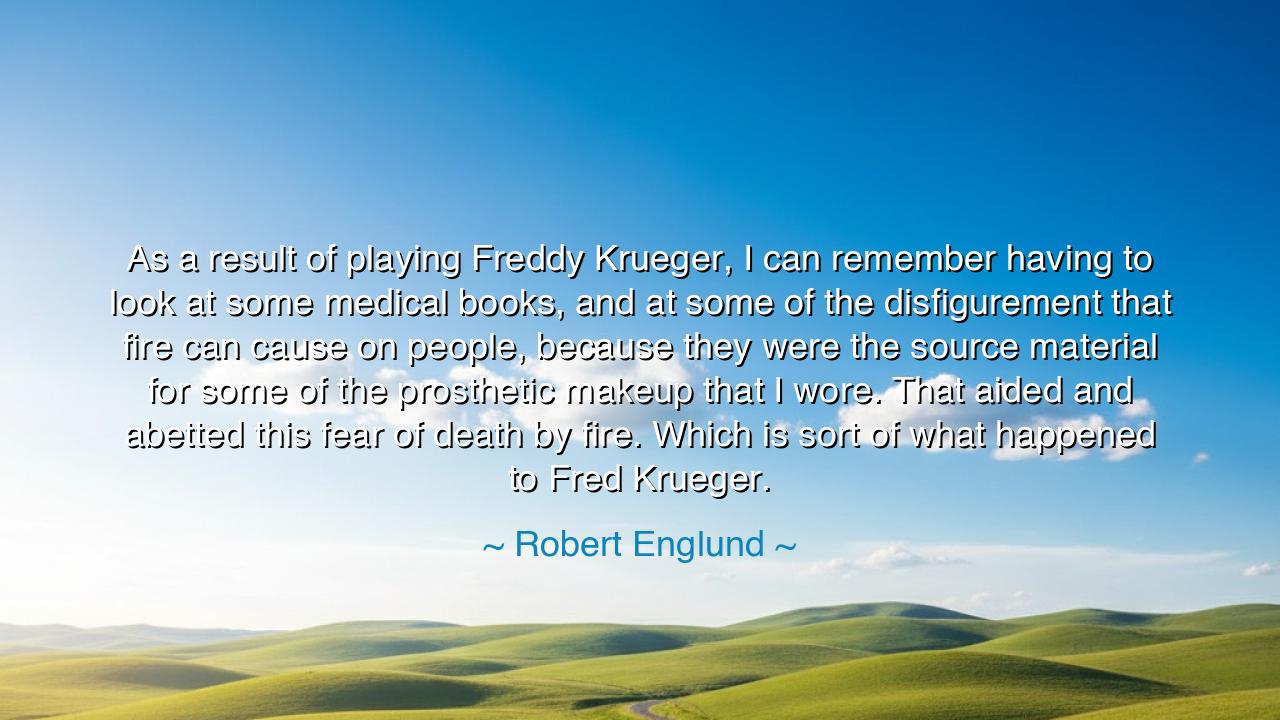
As a result of playing Freddy Krueger, I can remember having to
As a result of playing Freddy Krueger, I can remember having to look at some medical books, and at some of the disfigurement that fire can cause on people, because they were the source material for some of the prosthetic makeup that I wore. That aided and abetted this fear of death by fire. Which is sort of what happened to Fred Krueger.






When Robert Englund confessed, “As a result of playing Freddy Krueger, I can remember having to look at some medical books, and at some of the disfigurement that fire can cause on people, because they were the source material for some of the prosthetic makeup that I wore. That aided and abetted this fear of death by fire. Which is sort of what happened to Fred Krueger,” he revealed a truth deeper than mere acting. In his words lies the recognition that art, when pursued with seriousness, does not merely borrow from life—it confronts life, even its most terrible realities. He reminds us that to embody horror on screen, he had to face the real horrors of fire and disfigurement, horrors that scar both flesh and imagination.
The first truth he speaks is the necessity of study and immersion. To play Freddy Krueger, a figure of nightmares, Englund did not rely only on imagination. He turned to medical books, to the stark images of burn victims, to the raw and unsettling reality of fire’s cruelty upon the human body. In doing so, he honored a long tradition of artists who delve into reality to bring forth authenticity. Just as painters studied anatomy to depict the body accurately, so did Englund immerse himself in the grim reality of burns to portray Krueger’s grotesque visage with honesty.
The second truth is the awakening of fear through knowledge. In looking at those images, Englund was not left untouched. Knowledge is double-edged: it enlightens, but it also unsettles. His fear of death by fire grew not from imagination alone, but from seeing how fire ravages flesh and spirit alike. Here we glimpse a profound paradox—sometimes to understand reality better is also to be haunted more deeply by it. Art does not shield us from fear; it often intensifies it, by forcing us to face truths we would rather avoid.
History gives us similar stories. Consider the Roman poet Lucretius, who described the plague at Athens in harrowing detail, not from rumor but from observation, so that readers might feel the full weight of human suffering. Or think of Francisco Goya, who painted the brutality of war with such intensity that his canvases became mirrors of horror. Like Englund, these artists confronted reality so directly that they themselves were scarred by it, yet their work gained power because of this very confrontation.
The deeper meaning of Englund’s words is that art and fear are intertwined. Freddy Krueger was a monster of nightmares, but he was born from the very real terror of fire, scars, and human cruelty. By embodying Krueger, Englund became a vessel for collective fear—he gave a face to what haunts humanity. And yet, his own fear became part of the performance, a strange merging of actor and role. This reveals that art does not exist in some sterile world of fantasy; it grows from life’s deepest wounds and fears.
For us, the lesson is clear: do not shy away from truth, even when it terrifies. Whether you are an artist, a student, or simply a soul navigating the world, remember that fear can be transformed into creation, into expression, into meaning. Englund’s dread of fire became fuel for a character that terrified generations, but also opened conversations about horror, trauma, and the darker parts of the human psyche. What terrifies you may also inspire you—if you face it with courage.
Practical wisdom follows: confront your fears, study them, name them, and transform them into strength. If you are an artist, let them flow into your work. If you are a parent or teacher, use them to cultivate empathy for those who suffer. If you are an individual struggling with private fears, remember that by facing them, you disarm them. Fear does not vanish when ignored—it vanishes when given shape and meaning.
Thus, Robert Englund’s words remind us of the eternal link between art, fear, and truth. **The medical books, the disfigurement, the fire—**these were not just props for a role, but the raw substance of humanity’s oldest terror. Yet from them arose a performance that endures in cultural memory. Let us then learn as he did: to face the fire of our fears, not to be consumed by it, but to transform it into something that endures beyond ourselves.






AAdministratorAdministrator
Welcome, honored guests. Please leave a comment, we will respond soon